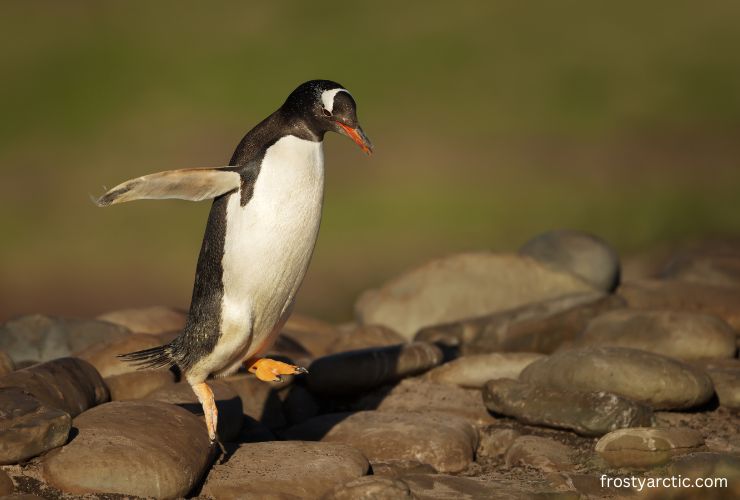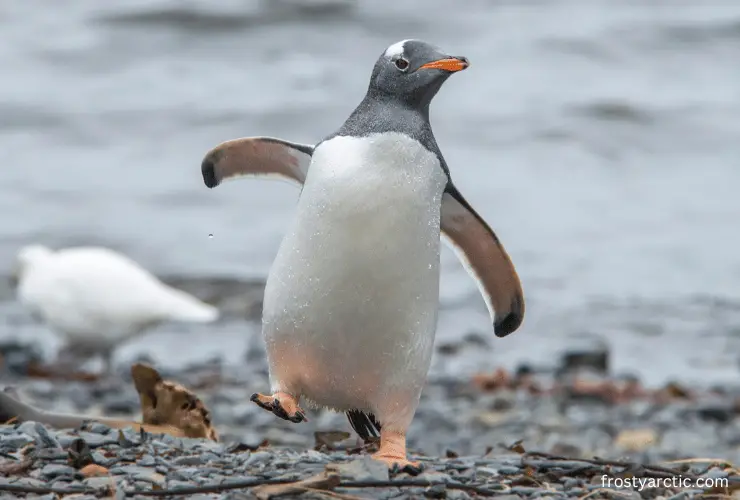No, penguins do not have fins. They have flippers, which are flattened, paddle-shaped wings that help them swim through water. These flippers are covered in short, scale-like feathers that help reduce drag and provide insulation.
Penguins also use their flippers for balance when walking on land. Let’s learn more about penguins and their flippers which help them survive their aquatic lives.
Why Are Penguins Considered Birds?
Penguins are considered birds because they have feathers, lay eggs, and have wings, although they are not capable of flight.
Penguins are part of the family Spheniscidae and are closely related to other flightless birds such as ostriches and emus.
They are also adapted for an aquatic lifestyle, with streamlined bodies and flippers that enable them to swim and dive in the ocean.
Despite their flightlessness, penguins are still classified as birds based on their genetic and physical characteristics. ~ American Museum of Natural History
Do Penguins Have Fins or Wings?
Penguins have wings, but they are modified into flippers for swimming rather than flying. These flippers have a streamlined shape that allows them to move through the water with great speed and agility.

While penguins cannot fly, their wings are still important for swimming and maintaining balance on land.
They use their wings to “porpoise” in the water, leaping out of the water to breathe and then diving back down to hunt for fish.
Evolution of Penguin Wings to Work as Flippers?
Penguin wings evolved to work as flippers through a process of natural selection, where individuals with traits that conferred better swimming abilities were more likely to survive and reproduce.
Over time, the wings of penguins became more flattened and paddle-like, providing more surface area for efficient propulsion through the water.
In addition, penguin wings are covered in short, stiff feathers that reduce drag and turbulence as they swim.
These adaptations, along with modifications to the skeletal structure of the wings, have allowed penguins to become highly specialized swimmers.
What Do Penguins Use Their Flippers For?
Penguins use their flippers primarily for swimming and diving.
The flattened, paddle-like shape of their flippers provides surface area for propulsion through the water, while the short, scale-like feathers covering their flippers help reduce drag and turbulence.

Penguins also use their flippers for steering, making quick turns, and avoiding obstacles as they swim.
Fun Fact: On land, penguins use their flippers for balance and support, often standing upright with their flippers outstretched. ~ National Geographic
1. Penguin Flippers Aid to Save Energy While Swimming
To save energy while swimming, penguin flippers aid a lot. The paddle-like shape and stiff, scale-like feathers of their flippers allow penguins to swim efficiently through the water, reducing the amount of energy they need to expend.
In addition, penguins use a “porpoising” technique when swimming, where they leap out of the water and glide through the air to reduce drag and increase speed.
This technique also helps them save energy by reducing the amount of time they spend swimming on the surface.
2. Flippers Are Essential for Regulating Penguin Body Temperature

The scale-like feathers covering the flippers do provide some insulation and help reduce heat loss while swimming in cold water.
The feathers of a penguin provide waterproofing for the penguins when underwater. Water temperatures can fall as low as -2.2°C (28°F).
The tufts of down-on feather shafts trap air and provide about 80% of insulation to penguins.
3. Conservation of Heat
Penguins often tuck their flippers close to their bodies since it helps regulate their body temperatures in the cold temperatures of the Antarctic region.
4. Penguins Use Their Flippers in Courting Rituals
Penguins use their flippers in courting rituals. During courtship displays, male and female penguins may spread their flippers, wave them in the air, or tap them on the ground as a form of communication and display.
These displays can serve to attract mates, establish pair bonds, and signal social status.
5. Flippers Are Used for Movement on Land
Flippers are used for movement on land but not for walking.
Penguins typically use their flippers to maintain balance and support their bodies while sliding on their bellies or waddling across the ground.
The flippers are not adapted for walking, and penguins often move in an awkward, stumbling gait on land.
However, their flippers are essential for survival in their aquatic environment, where they enable efficient swimming and diving.
6. Sleep
The penguin’s sleeping position is quite interesting. Penguins tuck their bill under their flipper while sleeping.
Some scientists believe that this helps reduce the amount of heat loss through the face.
FAQs
What is a penguin’s wing called?
A penguin wing is called a flipper. It is flattened and paddle-like in shape and covered in short, stiff feathers that help the penguin swim efficiently through the water.
How are the flippers of dolphins and penguins analogous?
The flippers of dolphins and penguins are analogous in that they are both flattened and paddle-like, allowing for efficient propulsion through the water.
Why do penguins hold their flippers?
Penguins may hold their flippers for a variety of reasons, including thermoregulation, balance, and communication.
Conclusion
Penguin flippers are specialized adaptations that enable efficient swimming and diving in their aquatic environment.
Their feathers help reduce drag and turbulence in the water, allowing penguins to swim with minimal energy expenditure.
While flippers are not used for walking, they play an important role in balance and support on land. Flippers also serve as a means of communication and display during courtship rituals.
Despite their unique adaptations, penguins face numerous threats to their survival, including habitat loss, climate change, and overfishing, highlighting the importance of conservation efforts to protect these fascinating and unique animals.



2 thoughts on “Do Penguins Have Fins? [How Do They Swim?]”